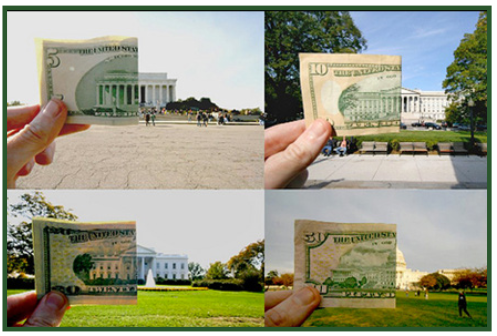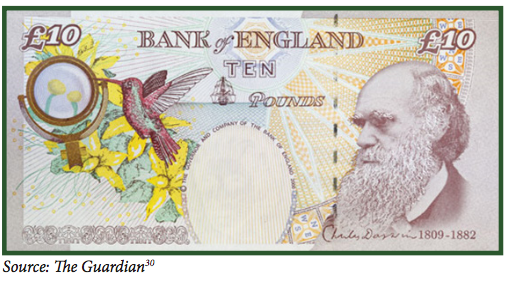News

Cash is educational
Friday, January 05, 2018
View Showroom
By Currency Research
What could be simpler than the piggy bank? This unassuming device teaches children around the world the value of money and the importance of saving, investing, and giving. The Money Savvy Generation’s “Money Savvy Pig,” below, is just one example of many.27

Central Bankers and educators have constantly and consciously used banknotes to inspire and educate the nation’s citizens. Cultural events and figures, architectural designs, flora and fauna, and more are depicted on banknotes around the world, serving as important emblems of national identity.

As Zhadnov points out, the recent revival of ‘scientific’ banknotes, such as the Bank of England’s Charles Darwin note, reflects a renewed dedication to science and educational development: “The new notes delight scientists but they should also inspire young minds — in contrast to the depersonalized euros of a unified Europe, which just indicate denominations of currency.”29 Such banknotes implicitly acknowledge the importance of inspiring younger generations to pursue the sciences.

Basil C. Gournaris, in “The Politics of Currency,” remarks on the symbolic significance of banknotes:
The educational uses of banknotes and coins can be profound. Scholar Samuel Hinton proposes a teaching module in Slovakian middle and high schools that utilizes Slovakian currency to educate students about cultural heritage and citizenship. Hinton recommends that this module be adapted to teach citizenship education to students around the world:
Hinton then discusses the following important questions about the relationship between currency and citizenship:
Banknotes and coins indeed play an important educational role. They teach children about the value of saving, investing, and giving, while also educating citizens and visitors about culturally and historically significant people and events essential to building and maintaining a nation’s collective identity.
This article has been posted with permission from Currency Research and is excerpted from The Case for Cash Part 2: The Justification. To request a copy of the full report or to learn more about Currency Research, please click here.
27 http://www.msgen.com/assembled/money_savvy_pig.html#.VL1VLmTF9rk
28 http://www.nature.com/nature/journal/v457/n7232/full/457956a.html
29 Ibid.
30 http://www.theguardian.com/business/gallery/2013/apr/26/banknotes-winston-churchill-predecessors-in-pictures
31 Chapter 4 in The Usable Past: Greek Metahistories, Keith S. Brown & Yannis Hamilakis (eds). Lanham, Maryland: Lexington Books, 2003: 70.
32 Samuel Hinton, Eastern Kentucky University Paper presented at the Annual Conference of the Comparative and International Education Society, Salt Lake City, Utah, March 2004. http://files.eric.ed.gov/fulltext/ED490359.pdf
33 http://files.eric.ed.gov/fulltext/ED490359.pdf
What could be simpler than the piggy bank? This unassuming device teaches children around the world the value of money and the importance of saving, investing, and giving. The Money Savvy Generation’s “Money Savvy Pig,” below, is just one example of many.27

Central Bankers and educators have constantly and consciously used banknotes to inspire and educate the nation’s citizens. Cultural events and figures, architectural designs, flora and fauna, and more are depicted on banknotes around the world, serving as important emblems of national identity.

SCIENTISTS ON TURKEY’S BANKNOTES SHOULD INSPIRE YOUNG MINDS
Countries that have adopted the euro as currency no longer commemorate their national identity with famous cultural figures on their banknotes: a sad loss. Gone, for example, are great scientists such as Carl Friedrich Gauss, who was portrayed on Germany’s 10-mark note, Pierre and Marie Curie from France’s 500-franc bill, and Alessandro Volta, with the demise of Italy’s 10,000-lira note.28
As Zhadnov points out, the recent revival of ‘scientific’ banknotes, such as the Bank of England’s Charles Darwin note, reflects a renewed dedication to science and educational development: “The new notes delight scientists but they should also inspire young minds — in contrast to the depersonalized euros of a unified Europe, which just indicate denominations of currency.”29 Such banknotes implicitly acknowledge the importance of inspiring younger generations to pursue the sciences.

Basil C. Gournaris, in “The Politics of Currency,” remarks on the symbolic significance of banknotes:
[They] are publicly shared in a way many symbols are not, as they circulate nationwide and across borders. They thus play a part in the continuous representation of a country both to its citizens and to an external audience. In some sense then they serve as the state’s educational mission of ‘teaching tradition’ to many. At the same time, they give clues as to the images that a wider public cherish ... banknotes thus have a double quantity, as their iconography is generated and shared where ‘people’ and ‘state’ meet.31
The educational uses of banknotes and coins can be profound. Scholar Samuel Hinton proposes a teaching module in Slovakian middle and high schools that utilizes Slovakian currency to educate students about cultural heritage and citizenship. Hinton recommends that this module be adapted to teach citizenship education to students around the world:
TEACHING ABOUT MONEY, CULTURAL HERITAGE AND CITIZENSHIP IN SLOVAKIA
One crucial role of the teacher of citizenship education is to facilitate and help legitimize the “pupils’ voice” in the classroom. The teacher should abdicate the “talking head” role and replace it with one that encourages and validates pupil ownership of knowledge. The purpose of this paper is to share some practical ways in which a module on citizenship education may be taught to students in the middle and high school levels in Slovakia.
One conclusion is that the teaching module on money, cultural heritage and citizenship education is a significant addition to the body of literature on teaching citizenship in the schools. The outcome is a description on how the module may be used by teachers in a middle or high school classroom to teach about citizenship education using Slovakian coins and bank notes. The author’s Recommendation is for the adaptation of this module using national currencies to teach about citizenship education in different countries. The first unit introduces the use of Slovakian banknotes and coins to teach about the country’s cultural heritage. The second unit is a lesson on the functions and roles of the National Bank of Slovakia.32
Hinton then discusses the following important questions about the relationship between currency and citizenship:
1. What is the relevance of a national currency to nationalism and citizenship in a newly democratic country?
2. Why are depictions of a country’s cultural heritage in the national currency significant in teaching about citizenship?
3. How can teachers in classrooms use the national currency to teach about citizenship?33
Banknotes and coins indeed play an important educational role. They teach children about the value of saving, investing, and giving, while also educating citizens and visitors about culturally and historically significant people and events essential to building and maintaining a nation’s collective identity.
This article has been posted with permission from Currency Research and is excerpted from The Case for Cash Part 2: The Justification. To request a copy of the full report or to learn more about Currency Research, please click here.
27 http://www.msgen.com/assembled/money_savvy_pig.html#.VL1VLmTF9rk
28 http://www.nature.com/nature/journal/v457/n7232/full/457956a.html
29 Ibid.
30 http://www.theguardian.com/business/gallery/2013/apr/26/banknotes-winston-churchill-predecessors-in-pictures
31 Chapter 4 in The Usable Past: Greek Metahistories, Keith S. Brown & Yannis Hamilakis (eds). Lanham, Maryland: Lexington Books, 2003: 70.
32 Samuel Hinton, Eastern Kentucky University Paper presented at the Annual Conference of the Comparative and International Education Society, Salt Lake City, Utah, March 2004. http://files.eric.ed.gov/fulltext/ED490359.pdf
33 http://files.eric.ed.gov/fulltext/ED490359.pdf
Additional Resources from ATM Industry Association
- 4/23/2024 - ATMIA Unveils Strategic Collaboration with Reconnaissance International to Elevate Intelligence & Networking Services to the ATM & Currency Industries
- 4/21/2024 - Fight Against Cashless Economy:
- 4/18/2024 - 3 myths about accepting cash at self service
- 4/18/2024 - Upcoming ATMIA/ASA Committee Meetings: April and May 2024
- 4/18/2024 - ATMIA Joins Atlanta Fed Meeting on Best Practices for ATM Cash Replenishment
- Show All ATM Industry Association Press Releases / Blog Posts



























